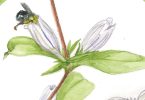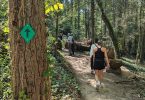
By Paula Musto
Among my most enduring childhood memories are road trips through rural Indiana to visit my grandparents. Inevitably, our automobile windshield would be splattered with the smashed remains of insects. Halfway through the drive from Chicago, a gas station stop meant someone—not infrequently me, the eldest sibling—would need to wipe away the mess while my dad filled the tank.
Recently, I drove the same roads en route to Asheville. I think I spotted a bug or two on the windshield when I arrived. It was late spring. Where were all the bugs?
Dwindling rapidly, according to wildlife biologists who estimate that more than 40 percent of insect populations are declining and a third are endangered. The rate of extinction for insects is said to be eight times faster than that of mammals, birds and reptiles.
If you’re a gardener who reaches for pesticides to keep the tiny creatures off your flowers or a camper who finds mosquitoes and flies a summertime nuisance, it may be good riddance. But according to scientists the decline is alarming.
“Insects are the foundation of the pyramid of life,” says Jim Costa, an entomologist and executive director of the Highlands Biological Station of Western Carolina University. “People need to recalibrate how they think of these animals. Insects are not pests, but a vital part of healthy ecosystems critical to our whole food chain.”
The six-legged creatures are a primary food source for birds, amphibians, reptiles, fish and mammals. Having fewer insects deprives these animals of vital nutrition, thereby disrupting ecosystems and our entire food chain. Most flowering plants and many crops depend on insect pollinators like bees, butterflies and beetles. If these insects disappear, yields of fruits and vegetables around the world would be decimated.
Costa, who has authored a number of books on insect behavior, and his wife Leslie, a scientific illustrator, are spending six weeks this summer in Great Smoky Mountains National Park as part of a residency program which provides writers the opportunity to immerse themselves in one of the most biologically diverse regions of any temperate zone worldwide. During their stay, the Costas are working on a field guide to help park visitors better understand and appreciate the wide variety of insects in the Smokies.
Insects, according to the couple, are among the most underappreciated animal groups in the world. While visitors to the Smokies are most often on the outlook for large mammals—namely, elk and bears—and favorite bird species, insects are largely overlooked. The writer–illustrator team hopes to change this and, in doing so, garner support for the tiny critters.
By illustrating insect signs—clues found on plants and amid the forest foliage signaling insect presence—the Costas hope to encourage park visitors to seek out the animals. For every insect sighted on a hike, chances are hundreds are also nearby, unseen. A squiggle on a leaf, for example, can signify insects within. A rolled or nibbled leaf, finely woven web, or tracings on tree trunks are other telltale signs of insect activity. Hikers can follow these clues to discover an assortment of beetles, flies, caterpillars and bees along with a world of lesser-known insects. Illustrations will help identify the critters and explain their behavior and ecology.
“Most folks who see these signs do not know that insects are around,” Costa says. “We see our project as a celebration of the Smokies and its extraordinary diversity as well as a way of educating nature lovers about an often neglected aspect of the park.”
Insects by far represent the largest number of animals in the wild—an estimated 300,000 different species, representing more than 90 percent of all named species, and scientists believe tens of thousands of species are still unknown. The Costas’ book will include the most commonly encountered species, illuminating their behavior, structures and tracings, aspects the casual observer may notice but have no idea about what they are.
“Most people are blind to insects, but anyone who cares about nature is missing out if they overlook these animals,” Costa says. “When you think about wildlife diversity in our highly diverse region, insects represent most of that diversity.”
Consider this: If the biomass of all the mammals, birds and reptiles on earth is weighed against the thousands of insect species, the feather-weight insects would collectively weigh more than all the other animals combined.
The Costas are on a mission. As conservationists often say: You cannot protect what you don’t know is there. The couple is striving to help park visitors not only learn more about insects but also to encourage them to take action to reverse the decline.
Backyard gardeners can provide valuable help by selecting native plants and trees, avoiding pesticides and leaving fallen leaves on the ground. Wildlife, especially insects, need what we consider yard debris for food and shelter.
The writer–illustrator team is a recipient of the 2025 Kemp Residency, a program of park partner Smokies Life named in honor of longtime writer, editor and publisher Steve Kemp. Their insect guide is a work in progress, but once published will be available in bookstores at park visitor centers. In the meantime, be on the lookout for bugs the next time you visit the park or anytime you’re outdoors. We need them!
Paula Musto is a writer and volunteer for Appalachian Wildlife Refuge which cares for injured and orphaned wildlife. To learn more, visit ApplachianWild.com.






